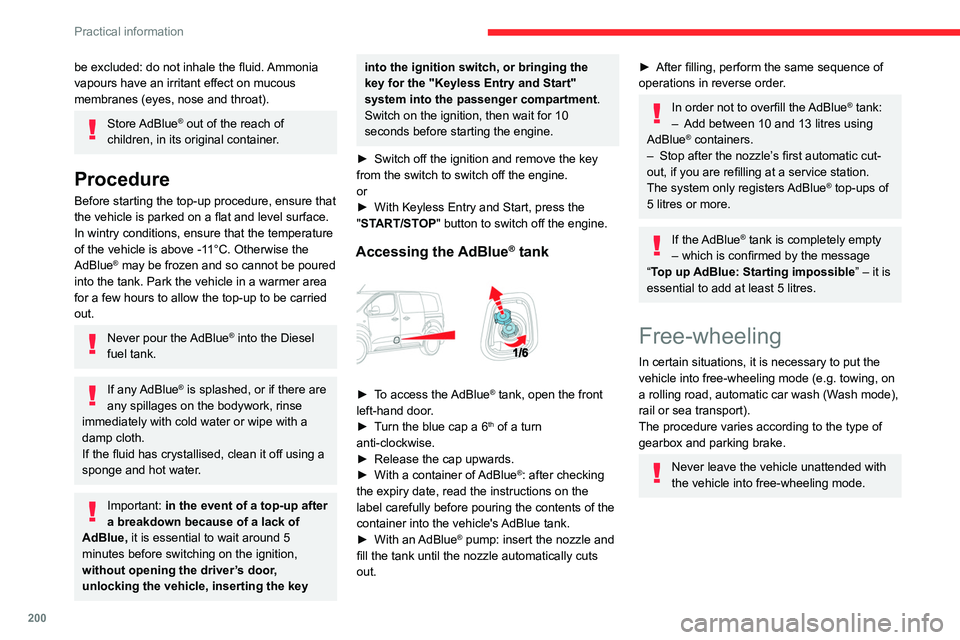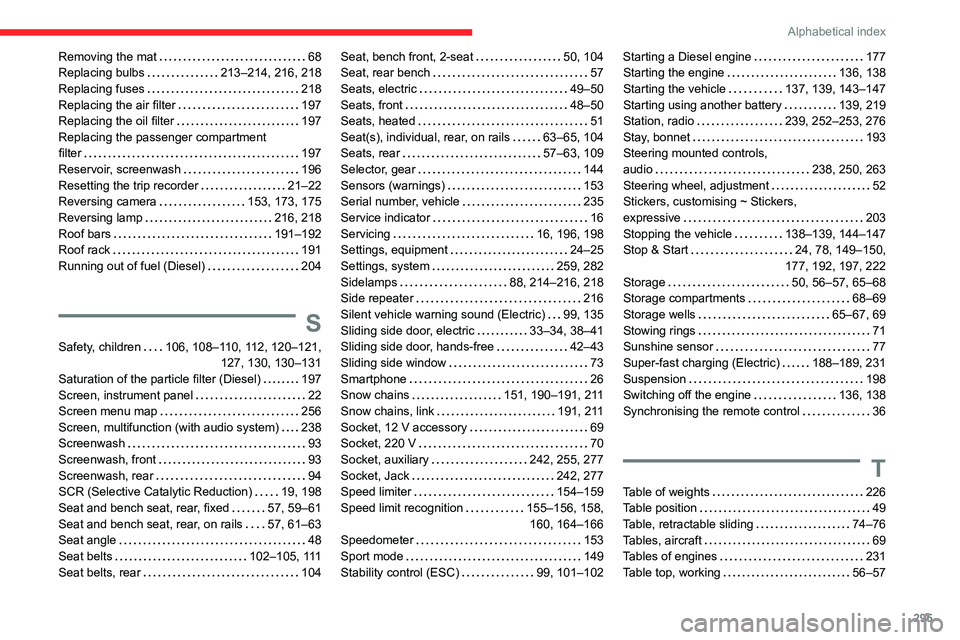sport mode CITROEN JUMPY 2022 Owners Manual
[x] Cancel search | Manufacturer: CITROEN, Model Year: 2022, Model line: JUMPY, Model: CITROEN JUMPY 2022Pages: 324, PDF Size: 10.05 MB
Page 153 of 324

151
Driving
6The system triggers an alert as soon as it
detects a drop in the inflation pressure of one or
more tyres.
Under-inflation detection does not
replace the need for vigilance on the part
of the driver.
This system does not avoid the need to
regularly check the tyre pressures (including
the spare wheel) as well as before a long
journey.
Driving with under-inflated tyres, particularly
in adverse conditions (heavy load, high
speed, long journey):
–
worsens road-holding,
–
lengthens braking distances,
–
causes premature wear of the tyres,
–
increases fuel consumption.
The inflation pressures specified for the vehicle can be found on the tyre pressure
label.
For more information on the Identification
markings, refer to the corresponding section.
Checking tyre pressures
This check should be done when the
tyres are "cold" (vehicle stopped for 1 hour or
after a journey of less than 6 miles (10
km) at
moderate speeds).
Otherwise, add 0.3
bar to the pressures
shown on the label.
Snow chains
The system does not have to be
reinitialised after fitting or removing snow
chains.
Spare wheel
The steel spare wheel does not have an
under-inflation detection sensor.
Under-inflation alert
This is signalled by the fixed illumination of this warning lamp, accompanied by an
audible signal and, depending on equipment, the
display of a message.
►
Reduce speed immediately
, avoid excessive
steering movements and avoid sudden braking.
►
Stop the vehicle as soon as it is safe to do
so.
The loss of pressure detected may not always cause visible deformation of the
tyre.
Do not rely on just a visual check.
►
Using a compressor
, such as the one in
the temporary puncture repair kit, check the
pressures of all four tyres when cold.
►
If it is not possible to carry out this check
immediately
, drive carefully at reduced speed.
►
In the event of a puncture, use the
temporary puncture repair kit or the spare wheel
(depending on equipment).
Driving too slowly may not ensure
optimum monitoring.
The alert is not immediately triggered in the
event of a sudden loss of pressure or tyre
blow-out. This is because analysis of the
values read by the wheel's speed sensors
can take several minutes.
The alert may be delayed at speeds below
25 mph (40 km/h), or when adopting a sporty
driving mode.
The alert is kept active until the system is reinitialised.
Reinitialisation
► The system must be reinitialised after any
adjustment to the pressure of one or more tyres,
and after changing one or more wheels.
Before reinitialising the system, make
sure that the pressures of the four tyres
are correct for the conditions of use of the
vehicle and conform to the values written on
the tyre pressure label.
Check the pressures of the four tyres before
performing the reinitialisation.
The system does not advise if a pressure is
incorrect at the time of reinitialisation.
Page 202 of 324

200
Practical information
be excluded: do not inhale the fluid. Ammonia
vapours have an irritant effect on mucous
membranes (eyes, nose and throat).
Store AdBlue® out of the reach of
children, in its original container.
Procedure
Before starting the top-up procedure, ensure that
the vehicle is parked on a flat and level surface.
In wintry conditions, ensure that the temperature
of the vehicle is above -11°C. Otherwise the
AdBlue
® may be frozen and so cannot be poured
into the tank. Park the vehicle in a warmer area
for a few hours to allow the top-up to be carried
out.
Never pour the AdBlue® into the Diesel
fuel tank.
If any AdBlue® is splashed, or if there are
any spillages on the bodywork, rinse
immediately with cold water or wipe with a
damp cloth.
If the fluid has crystallised, clean it off using a
sponge and hot water.
Important: in the event of a top-up after
a breakdown because of a lack of
AdBlue, it is essential to wait around 5
minutes before switching on the ignition,
without opening the driver’s door,
unlocking the vehicle, inserting the key
into the ignition switch, or bringing the
key for the "Keyless Entry and Start"
system into the passenger compartment.
Switch on the ignition, then wait for 10
seconds before starting the engine.
►
Switch off the ignition and remove the key
from the switch to switch off the engine.
or
►
With Keyless Entry and Start, press the
"
START/STOP" button to switch off the engine.
Accessing the AdBlue® tank
► To access the AdBlue® tank, open the front
left-hand door.
►
T
urn the blue cap a 6
th of a turn
anti-clockwise.
►
Release the cap upwards.
►
With a container of
AdBlue
®: after checking
the expiry date, read the instructions on the
label carefully before pouring the contents of the
container into the vehicle's AdBlue tank.
►
With an
AdBlue® pump: insert the nozzle and
fill the tank until the nozzle automatically cuts
out.
► After filling, perform the same sequence of
operations in reverse order .
In order not to overfill the AdBlue® tank:
–
Add between 10 and 13 litres using
AdBlue® containers.
–
Stop after the nozzle’ s first automatic cut-
out, if you are refilling at a service station.
The system only registers AdBlue
® top-ups of
5
litres or more.
If the AdBlue® tank is completely empty
– which is confirmed by the message
“Top up
AdBlue: Starting impossible ” – it is
essential to add at least 5 litres.
Free-wheeling
In certain situations, it is necessary to put the
vehicle into free-wheeling mode (e.g. towing, on
a rolling road, automatic car wash (Wash mode),
rail or sea transport).
The procedure varies according to the type of
gearbox and parking brake.
Never leave the vehicle unattended with
the vehicle into free-wheeling mode.
Page 297 of 324

295
Alphabetical index
Removing the mat 68
Replacing bulbs
213–214, 216, 218
Replacing fuses
218
Replacing the air filter
197
Replacing the oil filter
197
Replacing the passenger compartment
filter
197
Reservoir, screenwash
196
Resetting the trip recorder
21–22
Reversing camera
153, 173, 175
Reversing lamp
216, 218
Roof bars
191–192
Roof rack
191
Running out of fuel (Diesel)
204
S
Safety, children 106, 108–110, 112, 120–121,
127, 130, 130–131
Saturation of the particle filter (Diesel)
197
Screen, instrument panel
22
Screen menu map
256
Screen, multifunction (with audio system)
238
Screenwash
93
Screenwash, front
93
Screenwash, rear
94
SCR (Selective Catalytic Reduction)
19, 198
Seat and bench seat, rear, fixed
57, 59–61
Seat and bench seat, rear, on rails
57, 61–63
Seat angle
48
Seat belts
102–105, 111
Seat belts, rear
104
Seat, bench front, 2-seat 50, 104
Seat, rear bench
57
Seats, electric
49–50
Seats, front
48–50
Seats, heated
51
Seat(s), individual, rear, on rails
63–65, 104
Seats, rear
57–63, 109
Selector, gear
144
Sensors (warnings)
153
Serial number, vehicle
235
Service indicator
16
Servicing
16, 196, 198
Settings, equipment
24–25
Settings, system
259, 282
Sidelamps
88, 214–216, 218
Side repeater
216
Silent vehicle warning sound (Electric)
99, 135
Sliding side door, electric
33–34, 38–41
Sliding side door, hands-free
42–43
Sliding side window
73
Smartphone
26
Snow chains
151, 190–191, 211
Snow chains, link
191, 211
Socket, 12 V accessory
69
Socket, 220 V
70
Socket, auxiliary
242, 255, 277
Socket, Jack
242, 277
Speed limiter
154–159
Speed limit recognition
155–156, 158, 160, 164–166
Speedometer
153
Sport mode
149
Stability control (ESC)
99, 101–102Starting a Diesel engine 177
Starting the engine
136, 138
Starting the vehicle
137, 139, 143–147
Starting using another battery
139, 219
Station, radio
239, 252–253, 276
Stay, bonnet
193
Steering mounted controls,
audio
238, 250, 263
Steering wheel, adjustment
52
Stickers, customising ~ Stickers,
expressive
203
Stopping the vehicle
138–139, 144–147
Stop & Start
24, 78, 149–150,
177, 192, 197, 222
Storage
50, 56–57, 65–68
Storage compartments
68–69
Storage wells
65–67, 69
Stowing rings
71
Sunshine sensor
77
Super-fast charging (Electric)
188–189, 231
Suspension
198
Switching off the engine
136, 138
Synchronising the remote control
36
T
Table of weights 226
Table position
49
Table, retractable sliding
74–76
Tables, aircraft
69
Tables of engines
231
Table top, working
56–57